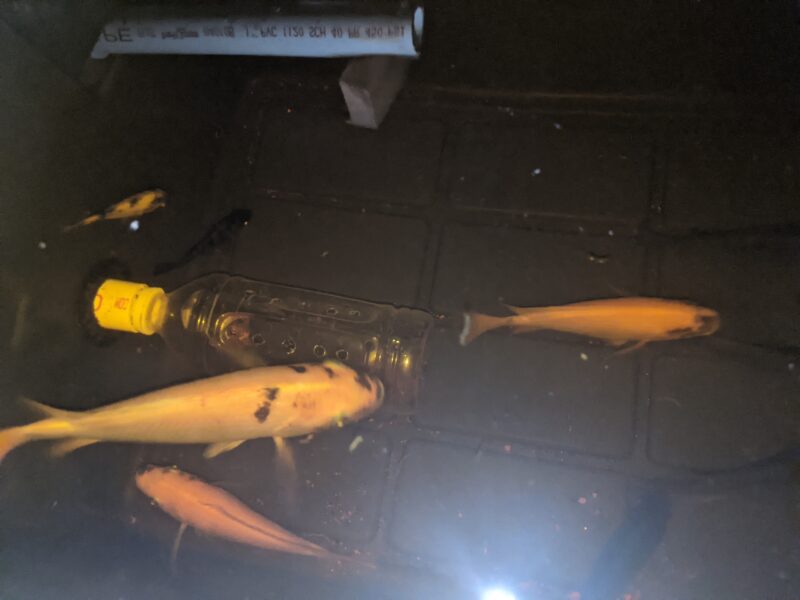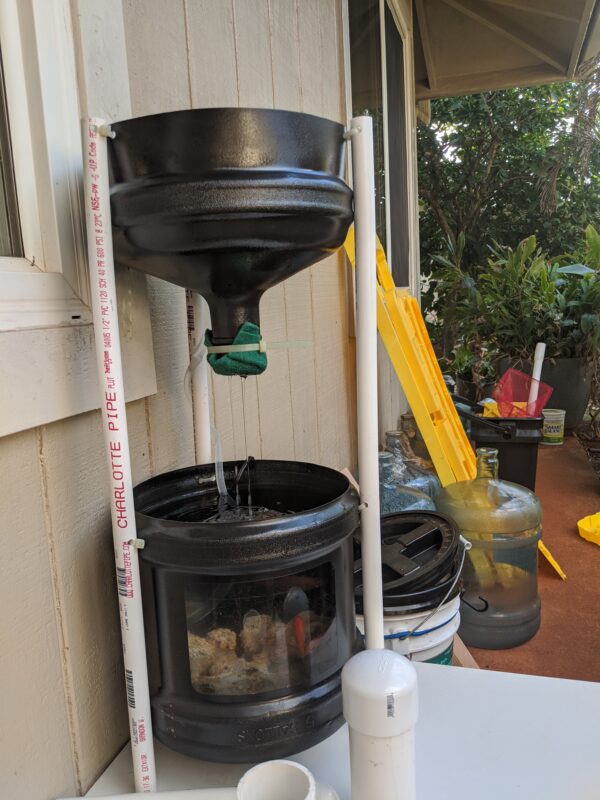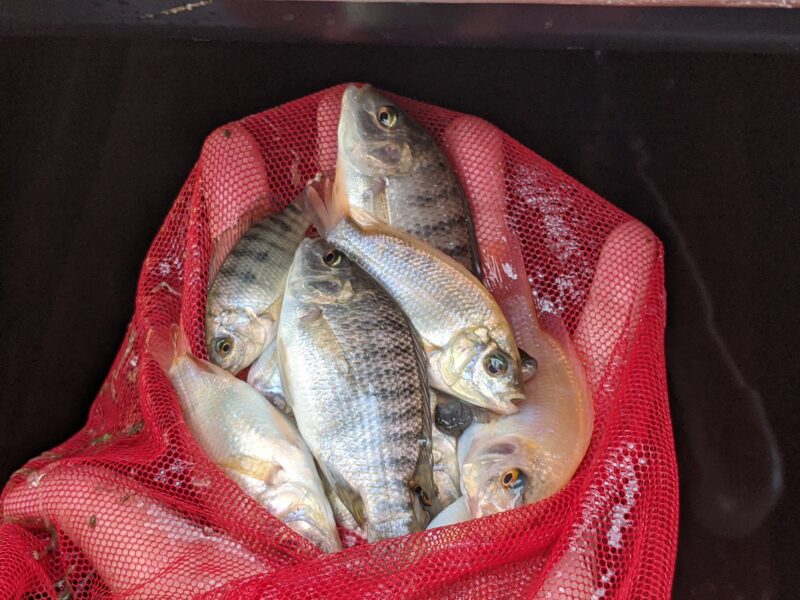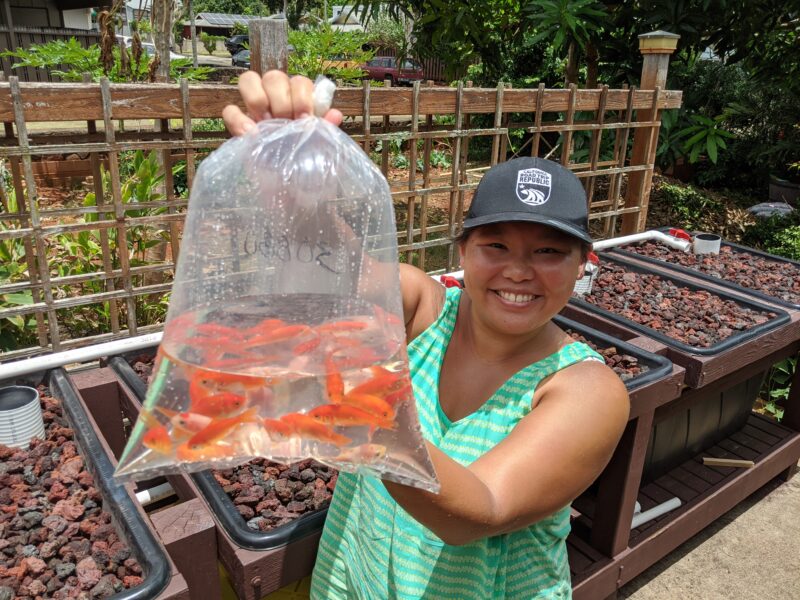This post may contain affiliate links, which means I'll earn a small commission if you purchase something through these links. You won't pay any extra; instead, you'll be helping Aloha With Love to thrive. Thank you! Learn more.
--
Finally, the fun part! It’s time to add some fish!
When you research aquaponics, you’ll discover that there’s a period of time where you need to “cycle” the water in order for the good bacteria to grow in the media. It takes about 1 – 2 months for full colonization (with black cinder) and this can be achieved through a variety of ways.
Read more: Building A 250+ Gallon Aquaponics System In My Front Yard (Part 3 – Lava Rock Installation)
In Hawaii, an easy way is to find someone who already has a fish pond and add their pond water to jumpstart the growth of those good bacteria. Basically, by adding ammonia (NH3, fish waste) to your system, 2 types of bacteria will begin to grow and convert ammonia to NO2, then NO3. This process is called nitrification and is important because ammonia is toxic and will eventually kill your fish.
Another method is to just buy ammonia and add it to your system. But since I was excited (and inexperienced) I decided to buy a small amount of fish that would introduce a little ammonia into the system. My brother Michael and I drove out to Coral Fish Hawaii and bought some cheap feeder fish that I could test my system with.
Feeder fish vs. tilapia
My system began with about 20 feeder fish. But I soon realized that feeder fish are very different in durability compared to the hardy tilapia I later added.
Within the first day most of them were sucked into the filter and died overnight. I spent the next week taking apart my bucket filter and trying to save them (they would die pretty quickly) while also experimenting with different barriers that would still suck in the solid waste but also keep out the feeder fish.
Dad finally came up with this plastic water bottle idea. By shaving down the external thread just a little bit, it made a perfect fit into the 1-inch PVC pipe that flowed into the filter. He drilled in several holes that still pulled in the solid waste, but weakened the water flow enough so that the feeder fish could swim near it without harm.


Tilapia for aquaponics
Tilapia make a fantastic choice for aquaponics in Hawaii. They get a bad rap because they can taste gross – but that’s when they’ve been living in dirty waters. They’re an extremely hardy fish that can survive in bad conditions. But if your aquaponics system has a good filter and your tilapia are living in clean water, they taste great!
They’re also cheap. You can find them being sold all over Hawaii from local fish farms, aquaponic stores, and individual sellers who need more space in their own aquaponic systems.
About 2 weeks in, I decided to add some tilapia fingerlings. I knew Craigslist would be my best bet and had already been keeping my eye out on Craigslist for over a month. In general, for the more common tilapia fingerlings, you can almost always find someone on Craigslist selling them for about 50 cents to a dollar each.
There are all types of tilapia being sold on Craigslist and it’s pretty hard to distinguish what’s what. The photos used on Craigslist are often old or blurry. Plus, nobody ever refers to their tilapia by the species name such as Nile or Mozambique. Instead, everyone refers to them by their color such as blue, grey, black, white, gold, and striped. Also, a lot of tilapia in Hawaii are hybrids, which makes determining their species nearly impossible.
In my opinion, it doesn’t really matter which color you get because they generally taste the same. Plus, the larger they get the more they will adversely affect your system due to the amount of food they consume and waste they produce. Unless you want certain colors for aesthetic purposes or would feel better serving a gold tilapia rather than a black one, buy whatever is available at the price point you can accept.
Local tip: There’s a lot of people who sell their tilapia for cheap because they need to thin out their aquaponics system or fish farm. In my case, I found a guy on Craigslist who was giving away tilapia fingerlings for free because his adult tilapia had given birth and he just didn’t have the room in his system. Score!

The person I got my tilapia from had no idea what kind of tilapia he had. But it was a good assortment of dark-striped tilapia and a light gold/orange variety. Some of the lighter tilapia have random black markings on them (mostly on their head), which make me think that the tilapia I have are hybrids.
The timing of adding fish to the aquaponics system
As I slowly added fish to my system, I was already transplanting vegetables from my Mom’s garden into the aquaponics system. I added simple vegetables such as watercress, jalapenos, basil, lettuce, and cilantro. While these grew somewhat, I noticed that their growth and health really started to take off when two things happened:
- I changed my red cinder media to black cinder.
- The fish were in the system for about 2 months (I assume the bacteria fully colonized and the system was working full-throttle).
True to what I read on the internet, it does seem that cycling your aquaponics system appropriately beforehand will save you a lot of trouble. My plants seemed to suffer from a range of nutrient deficiencies within those first two months. I struggled in the beginning to add more nutrients for healthier looking vegetables.
But after 2 months had passed until now (6 months later) I’ve only had to add small bits of nutrients (usually calcium) only a couple of times. The aquaponic system seems to really take care of itself ever since the nitrifying bacteria has had enough time to fully colonize.
6 months later
It’s been 6 months since I’ve added my tilapia fingerlings and only about 5 have died – two got stuck in the filter when I first added them in, another never grew larger for several months and seemed to die from natural causes, and the others jumped outside of their tank and dried up.
Most of them now measure 5 to 7 inches long and I have moved the larger tilapia to my IBC chop and flip aquaponics systems in the backyard. There are about 5 tilapia that are still on the smaller side (about 4 inches) and I have them in the same aquaponics system in the front yard.
A couple of things to note when you move tilapia to a different tank. I find that they like to jump out after they’ve been chased around with a net. They could jump anytime within a few minutes or after several hours. I think it’s due to the sudden stress of being chased that they end up jumping and unfortunately landing outside of their tank.
If you move your tilapia to a different tank, I highly suggest covering both tanks for a day so you don’t have to worry about discovering a dead fish. Other than that however, I’ve never had a problem with tilapia jumping out of their fish tank so I leave their tanks uncovered the rest of the time.
Also, the tilapia I have tend to take at least 2 full days to return to a normal eating routine after they’ve been transferred to a different tank. They might nibble once or twice the next day, but it takes a while for them to feel safe again while feeding.
Are you considering tilapia for your aquaponics system? What has your experience with tilapia for aquaponics been like so far? Let me know in the comments.
Aloha with love,
Amy


Great job on your aquaponics adventure! I enjoyed reading your posts about the builds, the fish, successes, and failures. I’m currently building my second aquaponics system and was looking for ideas and accidentally found your site. Thanks for sharing your stories!
Aloha Neil! Thanks for reading! It’s been a lot of fun so far. How are your systems doing? Are you in Hawaii, too?
I built 3 raised veg gardens with concrete blocks here is Waiahole Valley but am now considering going aquaponics and then also raising tilapia in a tank for the table. Is your aquaponics bed in full sun or is it covered with shade cloth?
Aloha Kathy!
Generally, I think most people in Hawaii doing aquaponics grow in full sun (like I do), but this depends entirely on what you want to plant. If you’re just going to experiment with different vegetables, then I recommend full sun. You can always cover it with shade cloth later if you find out you have a preference.
Aloha with love, Amy.